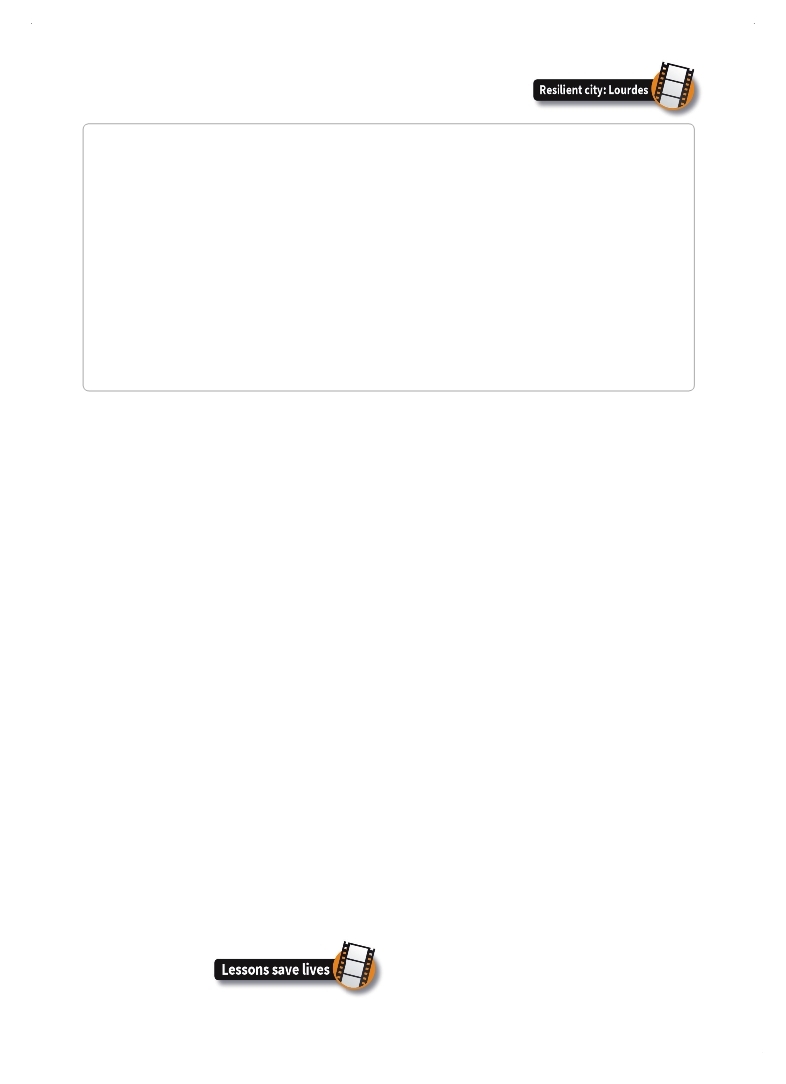 |
Global Assessment Report on Disaster Risk Reduction 2015
Making development sustainable: The future of disaster risk management |
 |
Global Assessment Report on Disaster Risk Reduction 2015
Making development sustainable: The future of disaster risk management |
|
|

140
Part II - Chapter 7
correspond to the short cycles of projects aimed at raising risk awareness in schools. On the other hand, the generic and global guidance in the HFA is often difficult to align to the sub-national contexts where curricula are often developed.
However, about 72 per cent of countries reporting through the HFA Monitor indicate that disaster risk reduction is included in some way in the national educational curriculum, with coverage in primary school curricula slightly higher than in secondary and university or professional programmes. Only about a third were able to report on the inclusion of disaster risk reduction in curricula at all education levels as well as in professional education programmes (
 UNICEF and UNESCO, 2014 UNICEF and UNESCO, 2014 UNICEF (United Nations Children Fund) and UNESCO (United Nations Educational, Scientific and Cultural Organization). 2014,Advances and continuing challenges towards HFA2 AND Post-2015: Background chapter, Background Paper prepared for the 2015 Global Assessment Report on Disaster Risk Reduction. Geneva, Switzerland: UNISDR.. UNICEF (United Nations Children Fund) and UNESCO (United Nations Educational, Scientific and Cultural Organization). 2014,Advances and continuing challenges towards HFA2 AND Post-2015: Background chapter, Background Paper prepared for the 2015 Global Assessment Report on Disaster Risk Reduction. Geneva, Switzerland: UNISDR.. Click here to view this GAR paper. While there is little systematic research on changing perceptions, anecdotal evidence shows that preparedness drills and simulation activities in schools (Box 7.5) may make an important contribution to risk awareness, particularly amongst children and youths.
Children’s engagement in school disaster management, including risk assessment and active problem-solving, lays the foundation for critical thinking and promotes an increasing willingness to take on other challenges. Engaging students and families in planning for educational continuity may also be a factor in reducing school drop-out rates when disasters occur (
 UNICEF and UNESCO, 2014 UNICEF and UNESCO, 2014 UNICEF (United Nations Children Fund) and UNESCO (United Nations Educational, Scientific and Cultural Organization). 2014,Advances and continuing challenges towards HFA2 AND Post-2015: Background chapter, Background Paper prepared for the 2015 Global Assessment Report on Disaster Risk Reduction. Geneva, Switzerland: UNISDR.. UNICEF (United Nations Children Fund) and UNESCO (United Nations Educational, Scientific and Cultural Organization). 2014,Advances and continuing challenges towards HFA2 AND Post-2015: Background chapter, Background Paper prepared for the 2015 Global Assessment Report on Disaster Risk Reduction. Geneva, Switzerland: UNISDR.. Click here to view this GAR paper. Rather than promoting disaster risk reduction as a stand-alone curricular subject, there are obvious synergies in combining it with related subjects, such as climate change. For example, Cambodia is promoting a combined disaster risk reduction and climate change adaptation curriculum that reduces the pressure on what is seen as an already overcrowded school curriculum. There are other examples where disaster risk reduction has been linked with topics like conflict and peace-building, sustainable development, other common localized risks, and with the underlying social, economic and political drivers of risk. Unfortunately the silo-like nature of the disaster risk management sector and institutional rivalries with other sectors such as climate change may be obstacles to this sort of integration.
Box 7.5 The role of children in strengthening preparedness
The United States and Australia have developed educational materials that foster leadership among school children in disaster preparedness and teach them how to share this information with others. Looking at children as active agents of change instead of objects that need to be protected can broaden the scope of education and its future impact. Several programmes have been developed in order to develop children’s awareness of and capacities for DRR, such as Save the Children’s school safety programmes or the Children’s Charter for Disaster Risk Reduction (Children in a Changing Climate Coalition, 2011
Children in a Changing Climate Coalition. 2011,Children and Disasters: Understanding Impact and Enabling Agency, Research Report authored by Fran Seballos, Marcela Tarazona, Jose Gallegos and Thomas Tanner. May 2011. Brighton: Institute of Development Studies.. . In France, The Memo’Risks initiative has been operating in the Loire River catchment area since 2004 and brings together local governments and schools to survey local disaster risk awareness (UNISDR et al., 2010 UNISDR, ITC-ILO (International Training Center - International Labour Organization), UNDP (United Nations Development Programme). 2010,Local Governments and Disaster Risk Reduction, Good practices and Lessons Learned: A contribution to the “Making Cities Resilient” Campaign, Contribution to the “Making Cities Resilient” Campaign 2010-2011. Geneva.. . |
 
Page 1Page 10Page 20Page 30Page 40Page 50Page 60Page 70Page 80Page 90Page 100Page 110Page 120Page 130Page 131Page 132Page 133Page 134Page 135Page 136Page 137Page 138Page 139Page 140Page 141->Page 142Page 143Page 144Page 145Page 146Page 147Page 148Page 149Page 150Page 151Page 152Page 153Page 154Page 160Page 170Page 180Page 190Page 200Page 210Page 220Page 230Page 240Page 250Page 260Page 270Page 280Page 290Page 300Page 310
|
|
 
|
 
|
